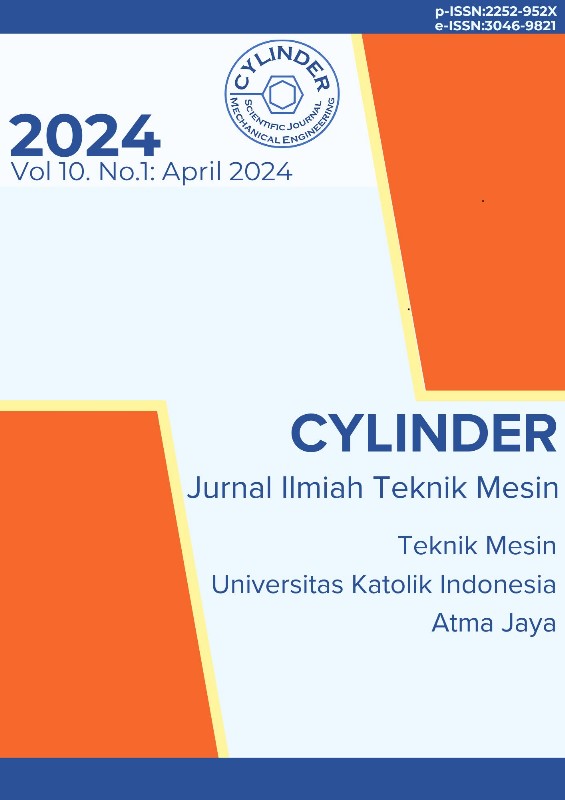Rancang Bangun Alat Kompres Demam Digital Suhu Hangat
DOI:
https://doi.org/10.25170/cylinder.v10i1.5479Keywords:
Arduino Uno, Heater, Tepid-water spongeAbstract
In this research, a digital fever compress device based on Arduino Uno was designed, utilizing warm temperature as a method for fever management. The device is equipped with a temperature sensor DHT, liquid crystal display (LCD), relay, and cartridge heater to create precise and controlled warm temperatures. The objective of this research is to design a digital fever compress device capable of generating warm temperatures ranging from 37.5°C to 42°C using Arduino Uno as the main microcontroller. The design process involved creating a model of temperature and tension equations, where the influential variables include ambient temperature, upper limit, and lower limit. Result shows the difference of the temperature values over time with the overall standard deviation of 1.4894, 1.6480, and 1.6217 and the overall standard deviation of the maxima and minima of 0.8085. The test results also indicated outcomes beyond the limits due to the large sampling time.
References
T. H. Y. Ling, L. J. Wong, J. E. H. Tan, and K. Y. Kiu, “Non-intrusive Human Body Temperature Acquisition and Monitoring System,” in 2015 6th International Conference on Intelligent Systems, Modelling and Simulation, Kuala Lumpur, Malaysia: IEEE, Feb. 2015, pp. 16–20. doi: 10.1109/ISMS.2015.17.
J. K. N. Mazima, M. Kisangiri, and D. Machuve, “Deign of Low Cost Blood Pressure and Body Temperature interface,” vol. 1, no. 10, 2013.
I. Rahmawati and D. Purwanto, “Efektifitas Perbedaan Kompres Hangat dan Dingin terhadap Perubahan Suhu Tubuh pada Anak di RSUD DR. Yunus Bengkulu,” unitri.
N. I. D. Zaman, Y. W. Hau, R. H. A. Al-Ashwal, and M. C. Leong, “A 2-in-1 Vital Sign Monitor with Smart Fever Type Classification for Home-Care Services,” in 2022 IEEE-EMBS Conference on Biomedical Engineering and Sciences (IECBES), 2022, pp. 88–93. doi: 10.1109/IECBES54088.2022.10079451.
Z. N. Al-Qudsy, R. M. Kanona, and S. A. Alyawer, “Expert System for Diagnosis Fever with Rash Diseases for Pediatric Age Group using Adaptive Neuro- Fuzzy Inference System,” in 2022 3rd Information Technology To Enhance e-learning and Other Application (IT-ELA), 2022, pp. 67–72. doi: 10.1109/IT-ELA57378.2022.10107936.
D. Burdakov and D. Peleg-Raibstein, “The hypothalamus as a primary coordinator of memory updating,” Physiology & Behavior, vol. 223, p. 112988, Sep. 2020, doi: 10.1016/j.physbeh.2020.112988.
“IEEE Standard for Safety Levels with Respect to Human Exposure to Electric, Magnetic, and Electromagnetic Fields, 0 Hz to 300 GHz.” IEEE. doi: 10.1109/IEEESTD.2019.8859679.
A. F. Fitriyah and M. Murniati, “Studi Kasus Penerapan Tepid Water Sponge Untuk Mengatasi Masalah Keperawatan Hipertermia pada Pasien Dengue Hemorraghic Fever (DHF),” JPPP, vol. 6, no. 2, pp. 659–666, Sep. 2023, doi: 10.37287/jppp.v6i2.2139.
F. A. Susanto, “PENGUKURAN SUHU TUBUH ONLINE SEBAGAI PENCEGAHAN PENYEBARAN VIRUS FLU DI LINGKUNGAN KAMPUS,” Jurnal Sistem Informasi dan Bisnis Cerdas, vol. 13, no. 2, pp. 67–74, Aug. 2020, doi: 10.33005/sibc.v13i2.2166.
F. Haman and D. P. Blondin, “Shivering thermogenesis in humans: Origin, contribution and metabolic requirement,” Temperature, vol. 4, no. 3, pp. 217–226, Jul. 2017, doi: 10.1080/23328940.2017.1328999.
Z. Wang, Y. Chen, and Y. Li, “Development of RC model for thermal dynamic analysis of buildings through model structure simplification,” Energy and Buildings, vol. 195, pp. 51–67, Jul. 2019, doi: 10.1016/j.enbuild.2019.04.042.
Downloads
Published
How to Cite
License
Copyright (c) 2024 Cylinder : Jurnal Ilmiah Teknik Mesin

This work is licensed under a Creative Commons Attribution 4.0 International License.

